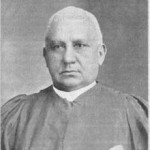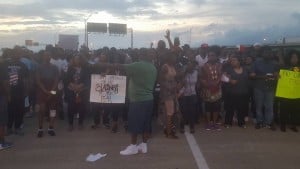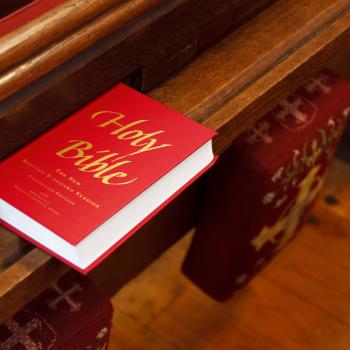In my previous post, I ended wanting to explore the connection between the black church (assuming the “non-white” context of the early Christian church) and the Black Lives Matter movement, discussing the theological and practical aspects of the movement as a possible extension of the black, or womanist, church in the 21st century. Moreover, drawing from the work of Albert Cleage, in what James Evans called an ecclesiology of praxis rather than one of the proclaimed Word” (156), I would like to suggest that this ecclesiology of praxis is made manifest in the foundation, structure, rhetoric and actions of the Black Lives Matter movement.
Exploring similarities between the movement and what W.E.B. Du Bois set forth as “the ‘marks’ of the black church: the music, the preaching, and the frenzy,” (J. Evans 144), in this post, I will question whether the Black Lives Matter movement might reasonably be contextualized as a hybrid of the contemporary black church, with its emphasis on community, refuge and wellness for the totality of one’s being (and not just the spiritual self), and of the Invisible Institution, subversive in nature, born of necessity, steeped in secrecy and imbued with the power of those who band together against institutional and social oppression, daring to proclaim words of liberation at the risk of great personal cost. In this analysis, and as a member of the millennial “church defecting” generation, I will also explore whether the rag-tag and rough-hewn elements of the protest movement might be understood to more closely resemble the vision of “ekklesia” set forth in the Christian Gospels and the epistles than does the contemporary church, regardless of the color of its congregants.
Contemporary definitions of church tend to focus equally on the building or gathering space used for worship, and on the individuals or corporate body making up the congregation. Church may also be understood as the overarching ecclesial organization that represents one particular denomination, or the Christian body of worship as a whole entity. In the days of the earliest church, however, “church” did not exist as a formal space for worship. Church was counter-cultural, subversive and dangerous business; the gathering spaces were covert and private, typically located in the homes of believers who had the means to accommodate a small gathering of worshippers. To this end, “church” in the first century was indicative of a body of believers, not a formal house of worship. Church was fluid and omnipresent, and could not be relegated to any one single space.
Emil Brunner, a neo-orthodox theologian, indicates a problem with translation that further marks a distinction between the modern Christian church and that of the first generation of believers. In the New Testament, the church is understood as a spiritual community referred to as the “ekklesia” – a word that appears 114 times in the Greek Septuagint translation, but only appears 44 times as “ecclesia” in the Latin Vulgate translation. Clearly, the creators of Scripture struggled to land upon a consistent and accurate word to represent the gathering of Christ followers bound together in love through the power of the Holy Spirit. “Ekklesia,” often translated to mean “church,” serves as the root word for “ecclesiology,” which is the study of the church, and “ecclesiastical,” roughly translated to mean that which is not secular. The term “church” has its origin in the Greek word “kyriakos,” which means “belonging to the Lord.” While each of these terms stems from a similar place of origin and may be understood as largely synonymous, Brunner asserts that “if we wish to follow the New Testament, we cannot simply translate Ekklesia by the word ‘Church,’ and we have the right to say only of the Ekklesia and not of the Church that it is essentially bound up with faith in Jesus Christ” (22). James Evans explains that “while Protestant Christianity emphasizes the personal dimension of faith, the ekklesia is, according to Brunner, the social form of faith” (148).
Although the individuals who have joined the Black Lives Matter movement may be the least likely individuals to claim that their work is “essentially bound up with faith in Jesus Christ,” this is not to be entirely unexpected. Christianity, which was once a risky and counter-cultural practice, is now one of the most mainstream, wholly Americanized and “vanilla” social institutions to which one can subscribe. We have appropriated the notion of what it means to be Christian, and we have bleached Jesus Christ so thoroughly over the course of 2,000 years that most all of his radicality has been scrubbed from the minds of those who profess to love and follow him. Many of the same individuals who claim to be Christian are the same individuals who both benefit from and propagate the systemic injustices against which the Black Lives Matter movement is crying out. As such, protestors may be both unwilling and unable to identify their cause with the radical works and teaching of Jesus, but the message of the movement – a leveling of the social infrastructure, and liberation from oppression for the marginalized – is perfectly in keeping with the message of the Gospel.
The Black Lives Matter movement is certainly subject to the effects of external, governmental law, but within the movement itself, one can surely recognize the dynamics of a spiritual personhood, inviting and functioning independently of a stifling hierarchical structure. The movement is emblematic of “ekklesia” in its resemblance to the inclusive, grassroots nature of the earliest Christian church, and in its spiritual character as a gathering of people bound in spirit, through love, to achieve a common good. As James Evans writes of ekklesia, “in this ideal community, the bonds are not formal or structured, but free-flowing, other-centered expressions of agape” (148-149).
Also important to note is that, while the earliest Christian church is not traditionally understood as a direct precursor to either the Invisible Institution or the contemporary black church, members of the early church were, geographically speaking, most certainly people of color. Cain Hope Felder, professor of New Testament at Howard University School of Divinity, speaks to this point in his critical efforts to establish a corrective, Afrocentric biblical hermeneutic. Felder declares that race, as understood as a modern social construct, was not a relevant factor in the first-century world’s social structure and class system. To be sure, ancient peoples experienced many disputes based on land, ethnicity, tribal disputes and other political, geographical and social concerns, but skin color “was by no means a political or ideological basis for enslaving, oppressing, or in any way demeaning other peoples” (Felder Race 127). According to our culture’s contemporary definition of “blackness” – constructed based on physical attributes and the presence of African blood in one’s lineage – many noteworthy individuals in scripture “would have to be classified as ‘Blacks’” (Felder Ideology 189). Felder argues that “many Black women and men are fully part of the salvation history within the Bible itself” (Ideology 191).
By this reasoning, if the earliest Christian church was comprised almost exclusively of “non-white” individuals, and many Afro-Asiatic individuals who were neither Greek nor Roman, then the early church could be argued to share more in common with the Invisible Institution of African American slavery than with the “traditional” fair-skinned church of European origin. Demonstrating a clear ontological connection between the first-century church and the secret slave church helps to lay the groundwork for an understanding of the Black Lives Matter movement as an extension of the ekklesia.
To be Continued
Read part 3 here













